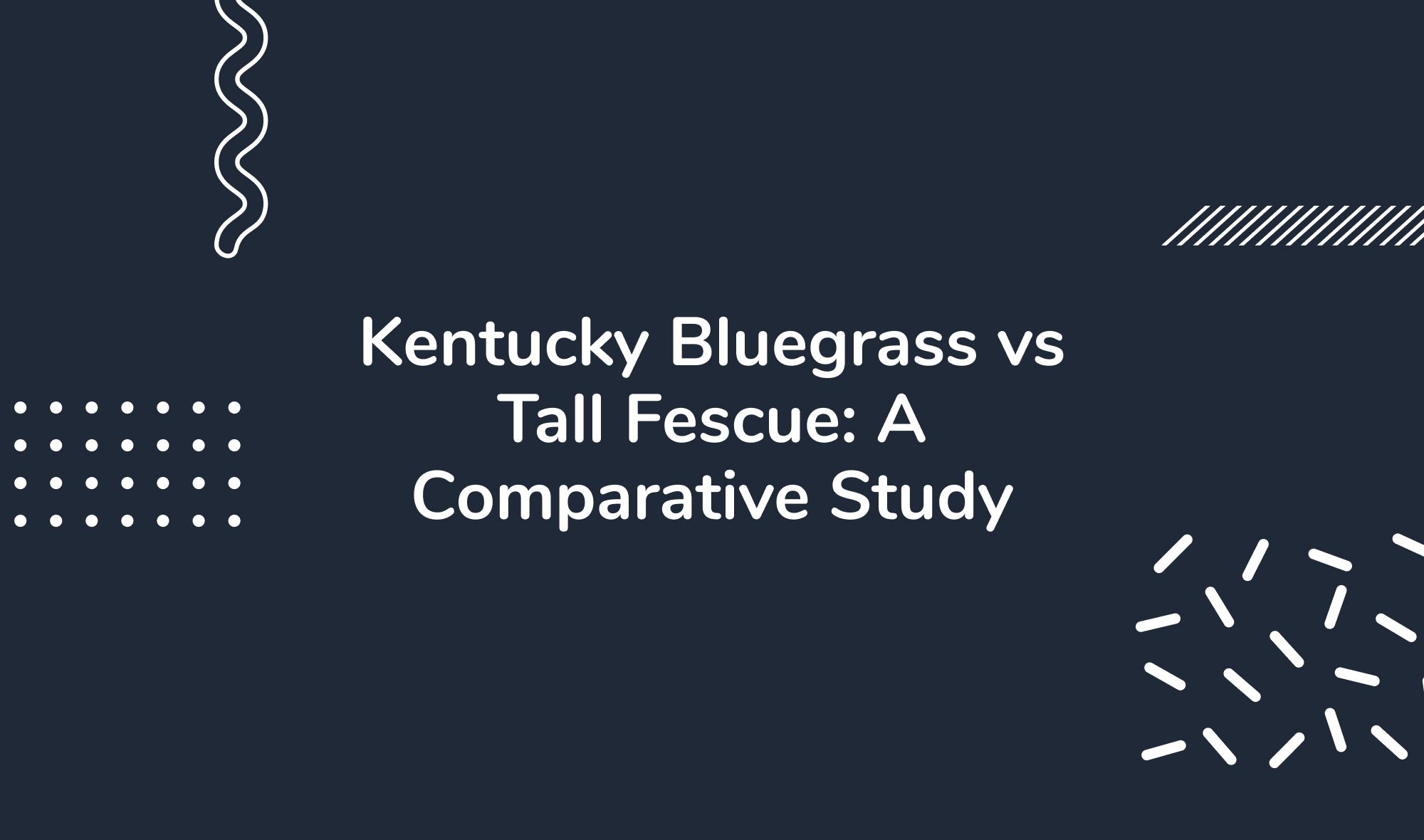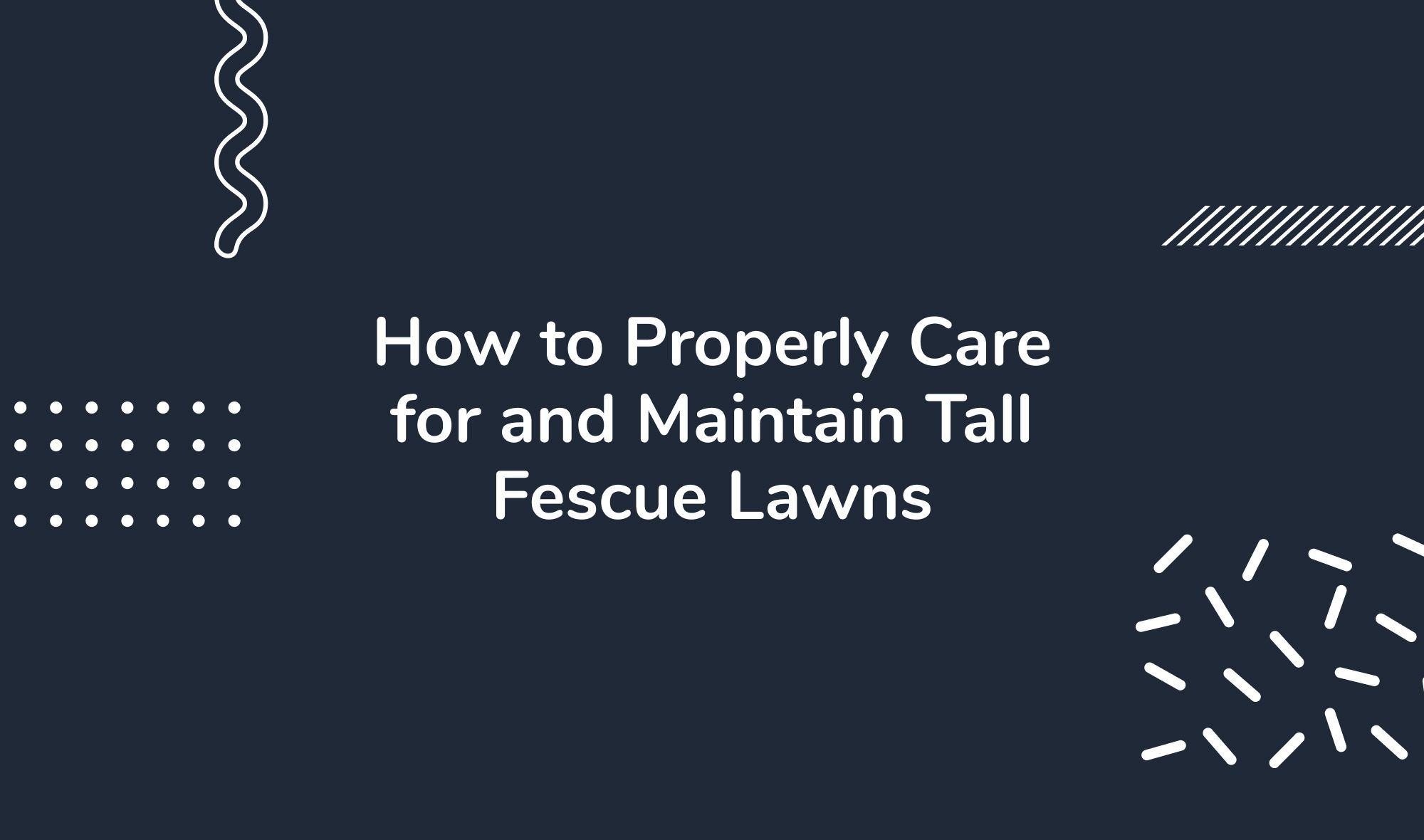Key Takeaways
- Tall fescue is a versatile, resilient cool season grass ideal for a range of lawn types.
- It stands out for its drought tolerance, deep root system, and ability to thrive in diverse soil conditions.
- Tall fescue sod provides a quick, robust lawn solution, excellent for weed prevention and erosion control.
- Proper care and maintenance are key to the health and aesthetics of a tall fescue lawn.

Have you ever stood in awe of a perfectly manicured lawn, its lush, dark green grass creating a carpet of tranquility? If you've dreamed of your lawn inspiring the same sense of wonder, you might just be in the right place. The key to such mesmerizing landscapes often lies beneath the surface, in the careful selection of grass seed. In this case, the magic ingredient could very well be tall fescue.
Tall fescue, a resilient cool season grass, is a popular choice among lawn enthusiasts for a multitude of reasons. Its dark green color and uniform growth habit add visual interest, while its superior heat and drought tolerance make it a reliable option even during the hot summer months. From home lawns in the transition zone to golf courses in the Pacific Northwest, tall fescue has proven its worth as a go-to option for creating a vibrant, resilient lawn.
As we delve deeper into the world of tall fescue, you'll discover its origins, its unique characteristics, and why it might just be the perfect grass for your lawn. We'll explore how to identify it, how it compares to other cool season grasses like Kentucky bluegrass and perennial ryegrass, and the different ways you can use fescue grass seed or tall fescue sod to transform your lawn. So, whether you're planting a new lawn or seeking to enhance an existing one, let's unearth the potential of tall fescue together.
Join our newsletter
Stay on top of the latest in landscaping and lawn care with one valuable tip right in your inbox every Saturday morning.
Why Choose Tall Fescue for Your Lawn?
If you're seeking a lawn that combines resilience with aesthetic appeal, tall fescue is a top contender. The benefits of tall fescue lawns extend beyond its deep green hues and hardy nature.
The Unique Benefits of Tall Fescue Lawns
Tall fescue stands out among other lawn grasses for its unique attributes. It is a turf type tall fescue, characterized by its dense growth habit, which helps in weed prevention by leaving little room for unwanted plants to take root. Thanks to an extensive root system, it exhibits superior heat and drought resistance. Its deep roots reach further down into the soil than many other grasses, enabling it to find nutrients and maintain soil moisture even in challenging conditions.
Whether you are dealing with sandy soils or battling summer heat, tall fescue lawns are designed to withstand adversity. Their resilience doesn't just apply to weather conditions; these grasses are also tolerant of moderate foot traffic, making them an ideal choice for families and pet owners. Furthermore, the tall fescues have a knack for self-repair. If bare spots appear, the surrounding grasses will grow to fill in the gaps, maintaining the uniform appearance of your lawn.
Tall Fescue Grass: A Cool Season Grass That Stands Out
While the term "cool season grass" encompasses a variety of grass types, including Kentucky bluegrass and perennial ryegrass, tall fescue grass holds its own. Unlike many cool season grasses, tall fescue boasts a superior heat tolerance, thriving even in the hot summer months typical of the transition zone. This allows it to maintain its dark green color longer than other cool season grasses.
But the benefits of tall fescue aren't limited to summer. Its peak growth periods are in the spring and fall, common for cool season grasses, but its deep root system allows it to endure the winter chill better than many other grass types.
It's this balance of aesthetic appeal and hardiness that makes tall fescue a popular choice among both homeowners and professionals. Whether you're seeking a grass type for your home lawn, a park, or even a golf course, tall fescue grass could be the perfect fit.
Getting Started with Tall Fescue

If the benefits of tall fescue have you convinced, the next step is to understand how to successfully plant and establish it in your lawn. It all starts with choosing the right fescue grass seed blend and preparing your lawn for seeding.
Choosing the Right Tall Fescue Grass Seed Blend
Selecting the appropriate fescue grass seed blend is critical to the success of your tall fescue lawn. Depending on the specific conditions of your lawn, different blends might be more suitable. For instance, there are turf type tall fescues, fine fescues, and dwarf type tall fescues, each with distinct characteristics.
Turf type tall fescues, for example, are known for their coarser texture, excellent drought tolerance, and resilience to foot traffic. Fine fescues, on the other hand, are best suited for areas with partial shade and low foot traffic. Dwarf type tall fescues, a relatively new variety, are prized for their slower growth rate, which translates to less frequent mowing.
When purchasing your grass seed, consider factors such as your region's climate, the soil conditions of your lawn, and your lawn's usage. It's worth consulting with a local lawn care professional or extension service to get advice tailored to your situation.
If you want to learn more about choosing the best Bermuda grass seed, check out our in-depth guide on Choosing The Best Bermuda Grass Seed.
Preparing Your Lawn for Tall Fescue Grass Seed
Once you've chosen your fescue grass seed blend, it's time to prepare your lawn. Proper preparation can significantly impact how well the grass seeds germinate and establish themselves.
Begin by removing any debris from the area to be seeded. Then, mow your lawn as short as possible without scalping it. This allows the seeds to reach the soil more easily and obtain good soil contact. It's also beneficial to aerate your lawn, especially if your soil is compacted. Aeration creates small holes in the soil, improving air circulation, water penetration, and providing a better environment for the grass seed to germinate and grow.
Next, consider testing your soil. This allows you to understand its pH level and nutrient content, helping you decide if any amendments are needed before planting. Tall fescue prefers slightly acidic to neutral soil (pH 5.5-7), and may require lime or sulfur to adjust the pH, or fertilizers to provide essential nutrients.
Lastly, when it's time to sow the seed, ensure an even distribution. You can achieve this by using a broadcast spreader. Remember to water the area thoroughly after sowing the seeds. The soil should be kept evenly moist until the seeds have germinated and new grass starts to establish.
Whether you're revitalizing an existing lawn or creating a new one from scratch, planting tall fescue can bring a sense of satisfaction and beauty to your home. In the following sections, we'll delve into how to identify tall fescue and compare it to other popular lawn grasses. We'll also discuss how to maintain your tall fescue lawn for the best results.
Identifying Tall Fescue

As you embark on your lawn care journey, it's crucial to recognize the grass you're dealing with. Accurate identification helps in providing the right care and treatment for your lawn. Here, we'll explore the key features to look out for when identifying tall fescue and how it compares to other common grasses.
Key Features for Tall Fescue Identification
Tall fescue has several distinguishing features that set it apart from other grasses. It's a bunch type grass that grows upright, resulting in a clumpy appearance if not well maintained. Its leaves are dark green, lending your lawn a lush, vibrant color.
One of the easiest ways to identify tall fescue is by looking closely at the leaves. The leaves of tall fescue are wider compared to many other grasses. They are typically about 1/4 to 1/2 inch wide, with the upper surface having distinct ridges and the lower surface smooth.
Another key feature of tall fescue is its extensive root system, which reaches deeper into the soil compared to most other grasses. Although not directly visible, this deep root system contributes to the grass's ability to withstand drought and find nutrients, even in less-than-ideal soil conditions.
Finally, tall fescue has vertical shoots called tillers. These tillers add to the grass's density, contributing to its lush appearance and its weed-resistant properties.
Join our newsletter
Stay ahead of the curve in all things outdoor.
Get the inside scoop on the latest landscaping, lawn care, and fencing trends with 1 actionable tip every Saturday morning.
Comparing and Contrasting Tall Fescue with Other Common Grasses
Tall fescue shares the stage with a variety of other grasses, each with its unique characteristics. Let's compare tall fescue with two common types: Kentucky bluegrass and Bermuda grass.
Kentucky bluegrass, another popular cool season grass, boasts a rich green color and a dense, carpet-like growth habit. Unlike tall fescue, it spreads via underground stems known as rhizomes, resulting in a uniform lawn. While Kentucky bluegrass is also tolerant of a range of soil conditions, it requires more regular watering and has less heat tolerance compared to tall fescue.
On the other hand, Bermuda grass is a common choice among warm season grasses. It spreads quickly, creating a dense, dark green lawn that's tolerant of heat and foot traffic. However, it requires a significant amount of sunlight and struggles in shaded areas, unlike tall fescue, which is more shade tolerant.
In the end, while other grasses might have their unique strengths, the deep roots, resilience, and lush appearance of tall fescue make it a versatile choice for various lawn conditions and climates. As we move to the next section, we'll dive deeper into the perennial debate of Kentucky bluegrass vs tall fescue and shed light on which might be a better fit for your lawn.
Kentucky Bluegrass vs Tall Fescue: A Comparative Study

Choosing the right type of grass for your lawn can be a challenging task, especially when you're caught between popular choices like Kentucky bluegrass and tall fescue. By diving into the strengths and weaknesses of each, and comparing their growth patterns, maintenance, and aesthetics, we can help you make an informed decision.
Understanding Kentucky Bluegrass: Strengths and Weaknesses
Kentucky bluegrass is often praised for its fine texture and visually pleasing, dense growth habit. This cool season grass transforms your lawn into a carpet of lush, deep green during its peak growth periods in spring and fall. Its ability to spread via rhizomes promotes a uniform and self-repairing lawn, making it a favorite among many homeowners.
However, Kentucky bluegrass has its drawbacks. While it flourishes in sunny areas, it struggles in heavy shade. It also requires regular irrigation to maintain its pristine appearance, particularly during hot and dry spells. Compared to tall fescue, Kentucky bluegrass has lower heat and drought tolerance, often entering dormancy in hot summer months if not adequately watered. This grass also needs a fair amount of maintenance, including regular mowing, fertilizing, and aeration, to maintain its beauty and health.
Comparing Growth Patterns, Maintenance, and Aesthetics
While both Kentucky bluegrass and tall fescue are considered cool season grasses, their growth patterns, maintenance needs, and visual appeal offer different experiences for lawn owners.
Tall fescue exhibits a clumping growth pattern due to its bunch type grass nature, contrasting with the uniform growth of Kentucky bluegrass. While some may find the clumping less visually appealing, this growth pattern contributes to its resilience against weeds.
When it comes to maintenance, tall fescue has a leg up, especially for homeowners who prefer a lower-maintenance lawn. Its deep root system makes it more drought-tolerant, requiring less watering during the hot summer months compared to Kentucky bluegrass. Its superior heat tolerance allows it to stay green and active during summer, unlike Kentucky bluegrass, which often enters dormancy unless watered frequently. Moreover, tall fescue’s shade tolerance gives it flexibility to thrive in a wider variety of lawn conditions.
Aesthetically, both grasses offer a beautiful, dark green color that can enhance the appearance of any lawn. While Kentucky bluegrass has a fine texture and carpet-like density, tall fescue offers a slightly coarser texture with a lush, dense appearance.
Both Kentucky bluegrass and tall fescue have their unique strengths, and your choice will largely depend on your specific lawn conditions, maintenance preferences, and personal tastes. Whether you go with the fine-textured, dense mat of Kentucky bluegrass, or the resilient, drought-tolerant tall fescue, your lawn will be the beneficiary of these wonderful cool season grasses.
Planting and Maintaining Your Tall Fescue Lawn

Transitioning your lawn to tall fescue or starting a new lawn from scratch involves careful planning and follow-through. After you've sown your tall fescue grass seed, it's equally important to maintain your lawn properly to ensure its continued health and beauty. Let's take a look at how you can do this.
The Process of Sowing Tall Fescue Grass Seed
Planting a new lawn with tall fescue begins with choosing the right fescue grass seed blend suitable for your region and specific lawn conditions. Once you have your seeds ready, it's time to prepare your soil.
Clear the lawn area of any debris, rocks, or existing grasses and weeds. Afterward, aerate the soil to improve its texture and ensure good seed-to-soil contact. Spread the grass seed evenly across the lawn, then lightly rake the area to cover the seeds with soil. To help the seeds germinate, maintain consistent soil moisture by watering the area lightly but frequently, especially during the first two weeks.
For optimal results, plant tall fescue grass seed in early fall. During this period, soil temperatures are still warm, encouraging germination, while air temperatures are cooling down, reducing evaporation. Moreover, most weed seeds are less likely to germinate in the fall, giving your tall fescue an edge.
How to Properly Care for and Maintain Tall Fescue Lawns

After sowing your tall fescue grass seed and watching it grow, proper maintenance is key to preserving your lawn's beauty and health.
Watering: Tall fescue's drought tolerance doesn't mean it's immune to water shortages. During dry periods, ensure your lawn receives about 1 to 1.5 inches of water weekly, including rainfall. Deep and infrequent watering promotes a stronger root system, enhancing the grass's resilience.
Mowing: Maintain a mowing height of about 3 to 4 inches for tall fescue lawns. This height helps the grass withstand stress from heat and drought while providing enough leaf surface for photosynthesis. Remember, never mow more than one-third of the grass blade at a time to avoid causing undue stress to the plant.
Fertilizing: Fertilize your tall fescue lawn in the fall and spring, when the grass is actively growing. An appropriate fertilizer will provide the nutrients necessary for the grass to stay healthy and resilient.
Weed Control: While tall fescue's density helps prevent weed invasion, some weed control might still be necessary. Apply pre-emergent herbicides in early spring to prevent weed germination and post-emergent herbicides as needed throughout the growing season.
Aeration: Because tall fescue can produce thatch, it's essential to aerate your lawn annually. This process allows water, nutrients, and oxygen to reach the grass's root zone more easily, promoting healthier growth.
With careful planting and diligent maintenance, your tall fescue lawn can provide a resilient, beautiful, and long-lasting landscape for your home. As you gain experience with your lawn, you'll find that the hardy nature of tall fescue makes it a reliable and rewarding choice for your lawn care journey.
Understanding Tall Fescue Sod

When starting a new lawn or repairing bare spots, using tall fescue sod can be a great option. Sod offers an almost instant solution, providing a dense, weed-free lawn that is immediately attractive and usable. Let's delve into the benefits and uses of tall fescue sod, as well as a step-by-step guide for installation.
Benefits and Uses of Tall Fescue Sod
Tall fescue sod offers several advantages over starting a lawn from seed. Firstly, sod allows you to establish a lawn quickly. Within a few weeks, you'll have a fully functional lawn that can withstand foot traffic, a feature particularly useful for households with children or pets.
Secondly, the dense nature of sod provides excellent weed prevention. With a sod lawn, there's little space for weeds to take hold, saving you time and effort battling unwanted intruders.
Lastly, tall fescue sod is a great choice for erosion control. If your property includes slopes or areas prone to soil erosion, installing sod can quickly stabilize the soil and prevent further erosion.
Tall fescue sod is a versatile solution used not only for home lawns but also in commercial landscapes, parks, golf courses, and sports fields. Its resilience and beauty make it a preferred choice for many situations.
Installing Tall Fescue Sod: Step-by-step Guide

- Prepare the Soil: Clear the area of rocks, debris, and existing grass. Till the soil to a depth of 4 to 6 inches and amend with compost or a soil conditioner for enhanced soil structure and nutrient content.
- Level the Ground: Rake the soil to a smooth, level surface. Remember, the soil surface should be 1 inch below the level of sprinkler heads or paved areas.
- Install the Sod: Start laying sod along a straight edge, such as a driveway or sidewalk. Butt the ends and sides of the sod strips tightly against each other but avoid overlapping. Stagger the joints in each row in a brick-like pattern to avoid erosion.
- Roll the Sod: After installation, use a lawn roller to ensure good contact between the sod and soil.
- Water Immediately: After installation, water the sod thoroughly. The soil should be kept consistently moist until the sod roots into the soil below.
- Mow and Maintain: Wait until the sod has rooted into the soil below before mowing, typically within 2 to 3 weeks after installation. Thereafter, maintain your tall fescue sod as you would a seeded tall fescue lawn.
With tall fescue sod, you can create a robust, ready-to-use lawn within weeks. The swift transformation and the durability of tall fescue make sod an excellent choice for many lawn owners. By following these steps for installation, you'll be on your way to enjoying your lush, green lawn in no time. And remember, every lawn is unique: experiment with your care routine, always keeping in mind the best practices.
Join our newsletter
Stay ahead of the curve in all things outdoor.
Get the inside scoop on the latest landscaping, lawn care, and fencing trends with 1 actionable tip every Saturday morning.